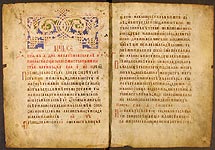Notated Menaion Sticherarion.
1422. Pskov. Nikola Kozhin's Monastery on the left bank of the Velikaya River. Scribe: Deacon Luke.
F (284ı210). 149 leaves. Several leaves are missing between fols. 99-100, 133-134.
Parchment. Ink, cinnabar, colours.
It is written in a uncial hand.
Znamenny notation without red-ink marks (known as the Shaidurov's marks) and black line-signs (the priznaki of Mezenets).
The decoration of the manuscript includes teratological head-piece in colours (fol. 1v). There are initials with motifs in the Old Byzantine style and in the South Slavic style in cinnabar and colours.
Folio 149v bears the scribe's inscription stating that the book was created in 1422 for the Nikola's Monastery by request of Coenobite Isaiah and the whole monastic community. The record also says that "silver was given by Mitrofan, a ladle maker, for his soul saving".
Maxim Brazhnikov noted that "this Sticherarion was untypical of the 15th century". Since, the earlier manuscript must have served as a model for the scribe. Not only material (parchment), on which the manuscript was written, but its paleographic characteristics demonstrate the compiler's devotion to the earlier traditions. Words in the text are written as they are pronounced. This is the ancient istinnorechie (actual pronunciation), the notatation, that is similar in the way of writing and the set of signs to the previous period. A head-piece and initials in the teratological style are also unusual for the 15th-century notated manuscripts. Liturgical services consists of hymns from the previous time, but their order corresponds with the Daily Cycle of Liturgical Services according to the Jerusalem Typicon.
This manuscript, like the codex at shelfmark —ÓÙ. 384, includes hymnes to Russian saints - St Theodosius of the Caves in Kiev and the Holy Martyrs Princes Boris and Gleb. The total number of feasts (139) is large enough for manuscripts from that time, although, it do not amount to the number of calendar dates, mentioned in the Ostromir Gospel.
In 1852 the manuscript came into the Imperial Public Library along with the other contents of the Mikhail Pogodin's collection.
Shelfmark: –Õ¡. œÓ„Ó‰. 45.





